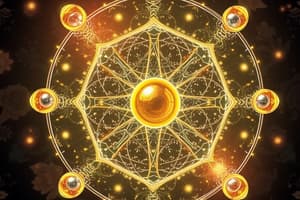Podcast
Questions and Answers
What is the overall charge of an atom's nucleus?
What is the overall charge of an atom's nucleus?
- Variable
- Negative
- Positive (correct)
- Neutral
Which model describes the atom as a small, dense central nucleus surrounded by orbiting electrons?
Which model describes the atom as a small, dense central nucleus surrounded by orbiting electrons?
- Electron Shell Model (correct)
- Rutherford Model
- Plum Pudding Model
- Quantum Mechanical Model
What is the maximum number of electrons that can occupy the second shell of an atom?
What is the maximum number of electrons that can occupy the second shell of an atom?
- 6
- 4
- 2
- 8 (correct)
What do protons, neutrons, and electrons all have in common?
What do protons, neutrons, and electrons all have in common?
How is mass number calculated for an atom?
How is mass number calculated for an atom?
What is the relative mass of an electron compared to protons and neutrons?
What is the relative mass of an electron compared to protons and neutrons?
In a neutral atom, what must be true about the number of protons and electrons?
In a neutral atom, what must be true about the number of protons and electrons?
What particle(s) contribute to the overall positive charge of the nucleus?
What particle(s) contribute to the overall positive charge of the nucleus?
What is relative atomic mass defined as?
What is relative atomic mass defined as?
Which statement about isotopes is correct?
Which statement about isotopes is correct?
What happens when an atom forms an ion?
What happens when an atom forms an ion?
What is the purpose of mass spectrometry?
What is the purpose of mass spectrometry?
During the ionisation stage of Time of Flight (TOF) mass spectrometry, what occurs?
During the ionisation stage of Time of Flight (TOF) mass spectrometry, what occurs?
What factor does not affect the path of ions in mass spectrometry during ion drift?
What factor does not affect the path of ions in mass spectrometry during ion drift?
Which of the following statements regarding the physical properties of isotopes is true?
Which of the following statements regarding the physical properties of isotopes is true?
What effect does gaining electrons have on an atom?
What effect does gaining electrons have on an atom?
Which orbital can hold a maximum of 10 electrons?
Which orbital can hold a maximum of 10 electrons?
What is the correct filling order of orbitals based on energy levels?
What is the correct filling order of orbitals based on energy levels?
Which of these statements about electron spins is correct?
Which of these statements about electron spins is correct?
Which of the following configurations represents Sodium correctly?
Which of the following configurations represents Sodium correctly?
What occurs when electrons are unpaired and unbalanced?
What occurs when electrons are unpaired and unbalanced?
Which rule states that no single orbital can hold more than two electrons?
Which rule states that no single orbital can hold more than two electrons?
How many energy levels does Sodium have based on its electron configuration?
How many energy levels does Sodium have based on its electron configuration?
Which orbital holds 6 electrons?
Which orbital holds 6 electrons?
What occurs when positive ions hit the negatively charged detection plate?
What occurs when positive ions hit the negatively charged detection plate?
How does the presence of a charged ion affect its path in mass spectrometry?
How does the presence of a charged ion affect its path in mass spectrometry?
In mass spectrometry analysis, how is the abundance of isotopes measured?
In mass spectrometry analysis, how is the abundance of isotopes measured?
What is the ratio of Cl+ ions observed in chlorine mass spectra?
What is the ratio of Cl+ ions observed in chlorine mass spectra?
How can the mass of chlorine isotopes be formed from Cl2+ ions?
How can the mass of chlorine isotopes be formed from Cl2+ ions?
What is a characteristic feature of electron orbitals?
What is a characteristic feature of electron orbitals?
What is demonstrated by the spectra of chlorine isotopes?
What is demonstrated by the spectra of chlorine isotopes?
In the calculation of average relative atomic mass (Ar) given the abundances, which of the following is correct?
In the calculation of average relative atomic mass (Ar) given the abundances, which of the following is correct?
What does ionisation energy refer to?
What does ionisation energy refer to?
How do successive ionisation energies typically behave?
How do successive ionisation energies typically behave?
What happens to the first ionisation energy as you move down a group in the Periodic Table?
What happens to the first ionisation energy as you move down a group in the Periodic Table?
What does a sudden large increase in ionisation energy indicate?
What does a sudden large increase in ionisation energy indicate?
Why is the first ionisation energy of Aluminium lower than expected?
Why is the first ionisation energy of Aluminium lower than expected?
What trend is observed for first ionisation energy across a period?
What trend is observed for first ionisation energy across a period?
What is the reason for the increase in ionisation energy when electrons are removed?
What is the reason for the increase in ionisation energy when electrons are removed?
What factor lessens the effect of electrostatic forces of attraction down a group in the Periodic Table?
What factor lessens the effect of electrostatic forces of attraction down a group in the Periodic Table?
Flashcards are hidden until you start studying
Study Notes
Fundamental Particles
- The model for atomic structure has evolved over time, with the current model consisting of a small, dense, positively charged nucleus surrounded by orbiting electrons in electron shells.
- This model was discovered through the Rutherford scattering experiment in 1911.
- The nucleus contains protons and neutrons, giving it a positive charge and holding almost all of the atom's mass.
- In a neutral atom, the number of protons and electrons is equal.
Determining the Number of Fundamental Particles
- Mass Number (A): Represents the sum of protons and neutrons in an atom.
- Atomic Number (Z): Represents the number of protons in an atom.
- Example: If Atomic Number = 7 and Mass Number = 14, then: Proton number = 7 and Neutron number = 14 - 7 = 7
Relative Atomic Mass and Isotopes
- Relative Atomic Mass (Ar): The mean mass of an atom of an element, divided by one twelfth of the mean mass of an atom of the carbon-12 isotope.
- Isotopes: Atoms of the same element with the same atomic number, but a different number of neutrons, resulting in a different mass number.
- Isotopes react chemically in the same way because their proton number and electron configuration is the same.
- However, isotopes have different physical properties due to their differing mass numbers.
Ions and Mass Spectrometry
- Ions: Formed when an atom loses or gains electrons, resulting in an overall charge.
- Mass Spectrometry: Analytical technique used to identify isotopes and determine the relative atomic mass of an element.
- Time of Flight (TOF) Mass Spectrometry: Records the time taken for isotopes to reach a detector, generating spectra displaying each isotope present.
- Steps in TOF Mass Spectrometry:
- Ionization: Sample vaporized and injected into a chamber, where high voltage causes electrons to be removed, creating +1 charged ions.
- Acceleration: Positively charged ions accelerated towards a negatively charged detection plate.
- Ion Drift: Ions deflected by a magnetic field into a curved path, with radius depending on charge and mass.
- Detection: Ions hit the detection plate, gain an electron, and produce a flow of charge. The greater the abundance, the greater the current.
- Analysis: Current values and flight times are used to generate a spectra printout showing isotope abundance.
Interpretation of Mass Spectra
- A 2+ charged ion will be affected more by the magnetic field, creating a path of smaller radius.
- This results in a halved m/z (mass to charge ratio) and is represented by a trace at half the expected m/z value on spectra.
Chlorine Spectra
- Mass spectra of chlorine display a characteristic pattern due to the presence of two isotopes:
- Cl+ ions: 3:1 ratio
- Cl2+ ions: 3:6:9 ratio
- This ratio arises from the different combinations of chlorine isotopes in the molecule.
Electron Configuration
- Electron Orbitals: Electrons are held in clouds of negative charge called orbitals. Different types of orbitals exist: s, p, d, and f, each with a unique shape.
- Electron Orbitals and the Periodic Table: These orbitals correspond to blocks on the Periodic Table, with each element in the block's outer electrons residing in that orbital.
- Electron Orbital Capacity: Each type of orbital can hold a specific number of electrons:
- s-orbital: 2 electrons
- p-orbital: 6 electrons
- d-orbital: 10 electrons
- Orbitals fill in order of increasing energy, from s to d, with each orbital completely filled before the next one is used.
- Electron Spin: Within orbitals, electrons pair up with opposite spin to achieve stability. This spin is represented by arrows.
Rules for Electron Configuration
- Lowest energy orbitals are filled first.
- Electrons with the same spin fill an orbital before pairing begins.
- No single orbital holds more than two electrons.
Exceptions to Electron Configuration Rules
- Unpaired Spins: Unpaired electrons with unbalanced spins create instability due to natural electron repulsion.
- Electron Rearrangement: Electrons may rearrange to achieve stability, leading to changes in electron configuration.
Ionisation Energy
- Definition: Minimum energy required to remove one mole of electrons from one mole of atoms in a gaseous state.
- Units: kJmol-1
- Successive Ionisation Energies: Ionization energies for removing subsequent electrons, typically requiring more energy due to increased electrostatic attraction between the nucleus and remaining electrons.
- Trends in First Ionisation Energy:
- Along a Period: Ionisation energy increases due to decreasing atomic radius and greater electrostatic forces of attraction.
- Down a Group: Ionisation energy decreases due to increasing atomic radius and shielding effects, reducing electrostatic force.
- Sudden Large Increase in Successive Ionisation Energies: Indicates a change in energy level as the electron is removed from a closer orbital, requiring more energy.
- Supporting Evidence for Atomic Orbital Theory: This large energy increase provides evidence for the atomic orbital theory.
- Aluminum Exception: Aluminum's first ionisation energy is lower than expected due to a single pair of electrons with opposite spins, causing repulsion and reducing the energy required to remove the outer electron.
Studying That Suits You
Use AI to generate personalized quizzes and flashcards to suit your learning preferences.




